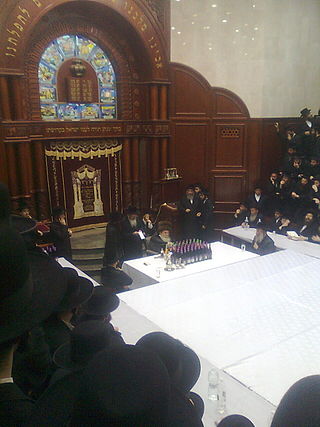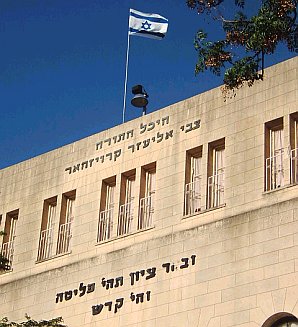
Vizhnitz is the name of a Hasidic dynasty founded by Rabbi Menachem Mendel Hager. Vizhnitz is the Yiddish name of Vyzhnytsia, a town in present-day Ukraine.

Nadvorna is a Hasidic rabbinical dynasty deriving its name from the town of Nadvorna, (Nadvirna), today in Ukraine.

Shomer Emunim is a devout, insular Hasidic group based in Jerusalem. It was founded in the 20th century by Rabbi Arele (Aharon) Roth.

A bekishe, bekeshe, or beketche, is a type of frock coat, usually made of black silk or polyester, worn by Hasidic Jews, and by some non-Hasidic Haredi Jews. The bekishe is worn mainly on Shabbos and Jewish holidays, or at weddings and other such events. During the week, it is customary to wear a rekel, made of wool or polyester, looking like a regular double-breasted suit, only longer. Hassidic rabbis who wear a bekishe during the week will wear a more ornate version for Shabbos, often lined with velvet or some color other than or in addition to black.

Skver is a Chasidic dynasty founded by Rebbe Yitzchok Twersky in the city of Skver, or Skvyra, in present-day Ukraine during the mid-19th century. Adherents of the rebbes of Skver are known as Skverer Hasidim.
Biala is a Hasidic dynasty originating from the city of Biała Rawska, where it was founded by R. Yaakov Yitzchak Rabinowicz (II). Biala is a branch of Peshischa Hasidism, as R. Yaakov Yitzchak Rabinowicz (II) was the great-grandson of R. Yaakov Yitzchak Rabinowicz, the first Peshischa Rebbe. The dynasty was originally spread throughout many towns in Poland, often taking the names of said towns. However, after the Holocaust, the name "Biala" become synonymous with the entire dynasty. Today the dynasty is mostly concentrated in Israel, America and Switzerland.
Karlin-Stolin is a Hasidic dynasty, originating with Rebbe Aaron ben Jacob of Karlin in present-day Belarus. One of the first centres of Hasidim to be set up in Lithuania, many Lithuanian Hasidic groups are its offshoots.
Zvhil is the name of a Hasidic dynasty, with adherents today in Jerusalem, Boston, and New York.
Dushinsky is one of the few Hasidic dynasties not named after the place where it originated; instead, it is named after the rebbe's surname. It is relatively new, and became a dynasty in Jerusalem, where it is centered today. Unlike other Hasidic groups, it does not originate from a Hasidic background, but from the talmidim (students) of Moses Sofer.

Pshevorsk is a small Hasidic movement based in Antwerp, Belgium, led by the Leiser rabbinical dynasty, originating in the Polish town of Przeworsk.

Sadigura is a Hasidic dynasty named for the city of Sadhora, Bukovina, which belonged to Austria. The dynasty began in 1850 with Rabbi Avrohom Yaakov Friedman, a son of Rabbi Yisrael Friedman of Ruzhyn, and was based in Sadigura until 1914. During the interwar period the dynasty was led by Rebbes in Vienna and Przemyśl, Poland, and on the eve of World War II was transplanted to Israel, where it thrives to this day.

Toldos Aharon is a devout, insular, fervently anti-Zionist Hasidic group. The group is characterized by extreme conservatism and a desire to preserve the life of the old Yishuv in Jerusalem, in sharp opposition to Zionism, in a strict Haredi way of life, in a special style of clothing, and in an emphasis on prayer at a moderate pace and with enthusiasm. Headquartered in Jerusalem's Mea Shearim neighborhood, it also has significant numbers in Ramat Beit Shemesh, and New York City, and additional members in Tiberias and in Harish. The sect has about 1,800 households. Toldos Aharon is a split-off from Shomer Emunim. It is led by its Rebbe, Dovid Kohn.

The Charedi Council of Jerusalem is a large Haredi Jewish communal organization based in Jerusalem, with several thousands affiliated households. It is led by an independent rabbinical court, chaired by the Gaon Convenor, acronymed Ga'avad, and operated by the Rabbi Convenor, Ra'avad. The Council provides facilities such as dietary laws supervision, ritual baths, a Sabbath enclosure, and welfare services. The Council was founded in 1921 by devout Ashkenazi residents of Jerusalem, especially of the Old Yishuv, who refused to be affiliated in any way with the new Zionist institutions.

Mezhbizh is the name of the town of Medzhybizh in the present Ukraine which is significant as both the source of a Hasidic dynasty that bears its name and as a symbolic name for the roots of Hasidism.

From the founding of political Zionism in the 1890s, Haredi Jewish leaders voiced objections to its secular orientation, and before the establishment of the State of Israel, the vast majority of Haredi Jews were opposed to Zionism, like early Reform Judaism, but with own reson. This was chiefly due to the concern that secular nationalism would redefine the Jewish nation from a religious community based in their alliance to God for whom adherence to religious laws were “the essence of the nation’s task, purpose, and right to exists,” to an ethnic group like any other as well as the view that it was forbidden for the Jews to re-constitute Jewish rule in the Land of Israel before the arrival of the Messiah. Those rabbis who did support Jewish resettlement in Palestine in the late 19th century had no intention to conquer Palestine and declare its independence from the rule of the Ottoman Turks, and some preferred that only observant Jews be allowed to settle there.

Aharon Roth or Aaron Rote known as Reb Arele (1894−1947), was a Hungarian Hasidic rebbe and Talmudic scholar. He first established a Hasidic community he called Shomer Emunim in the 1920s in Satu Mare and in the 1930s in Berehovo, before he settled in Jerusalem, where he also founded a Hasidic community of the same name. His main work is the two-volume Shomer Emunim, written in 1942 in reaction to the news about the Nazi atrocities in Eastern Europe.

Avrohom Yaakov Friedman was the fifth Rebbe of the Sadigura Hasidic dynasty. In 1979 he succeeded his father, the fourth Sadigura Rebbe, and took his seat on the Moetzes Gedolei HaTorah. He oversaw the growth of Sadigura communities in Israel and in London, Antwerp, and New York City.

Kiryat Shomrei Emunim is a Hasidic Jewish neighborhood in western Jerusalem. It was founded in the early 1960s by the Shomrei Emunim Rebbe, Rabbi Avrohom Chaim Roth.

Yisroel Moshe Friedman was the sixth Rebbe of the Sadigura Hasidic dynasty. He led his court from Bnei Brak, Israel.

Rabbi Avrohom Yitzchok Kohn was a Hasidic rabbi and founder of the Toldos Aharon Hasidim. He was the son-in-law of Rabbi Aharon Roth, and the Toldos Avrohom Yitzchok is named after him.














